See also
- German cruiser Prinz Eugen, German World War II heavy cruiser
- SMS Prinz Eugen, Austrian and Austro-Hungarian Navy ships
Eugen is a masculine given name. It may also refer to:
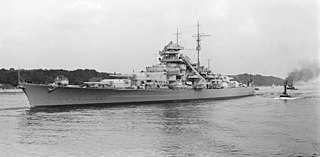
Bismarck was the first of two Bismarck-class battleships built for Nazi Germany's Kriegsmarine. Named after Chancellor Otto von Bismarck, the ship was laid down at the Blohm & Voss shipyard in Hamburg in July 1936 and launched in February 1939. Work was completed in August 1940, when she was commissioned into the German fleet. Bismarck and her sister ship Tirpitz were the largest battleships ever built by Germany, and two of the largest built by any European power.
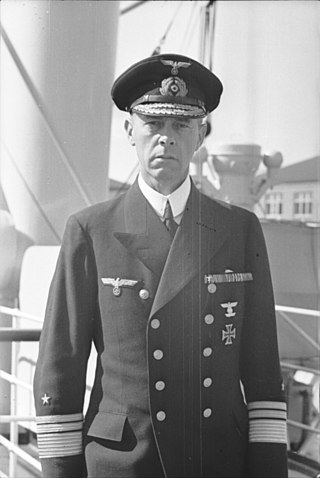
Operation Rheinübung was the sortie into the Atlantic by the new German battleship Bismarck and heavy cruiser Prinz Eugen on 18–27 May 1941, during World War II. This operation to block Allied shipping to the United Kingdom culminated with the sinking of Bismarck.
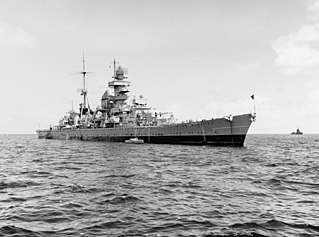
Prinz Eugen was an Admiral Hipper-class heavy cruiser, the third of a class of five vessels. She served with Nazi Germany's Kriegsmarine during World War II. The ship was laid down in April 1936, launched in August 1938, and entered service after the outbreak of war, in August 1940. She was named after Prince Eugene of Savoy, an 18th-century general in the service of Austria. She was armed with a main battery of eight 20.3 cm (8 in) guns and, although nominally under the 10,000-long-ton (10,160 t) limit set by the Anglo-German Naval Agreement, actually displaced over 16,000 long tons (16,257 t).

The Battle of the Denmark Strait was a naval engagement in the Second World War, which took place on 24 May 1941 between ships of the Royal Navy and the Kriegsmarine. The British battleship HMS Prince of Wales and the battlecruiser HMS Hood fought the German battleship Bismarck and the heavy cruiser Prinz Eugen, which were attempting to break out into the North Atlantic to attack Allied merchant shipping.

The Tegetthoff class was a class of four dreadnought battleships built for the Austro-Hungarian Navy. Named for Austrian Admiral Wilhelm von Tegetthoff, the class was composed of SMS Viribus Unitis, SMS Tegetthoff, SMS Prinz Eugen, and SMS Szent István. Construction started on the ships shortly before World War I; Viribus Unitis and Tegetthoff were both laid down in 1910, Prinz Eugen and Szent István followed in 1912. Three of the four warships were built in the Stabilimento Tecnico Triestino shipyard in Trieste; Szent István was built in the Ganz-Danubius shipyard in Fiume, so that both parts of the Dual Monarchy would participate in the construction of the ships. The Tegetthoff-class ships hold the distinction for being the first and only dreadnought battleships of the Austro-Hungarian Navy. The SMS Szent István had a different more modern propulsion system than her sister ships.

Leipzig was the lead ship of her class of light cruisers built by the German navy. She had one sister ship, Nürnberg. Leipzig was laid down in April 1928, was launched in October 1929, and was commissioned into the Reichsmarine in October 1931. Armed with a main battery of nine 15 cm (5.9 in) guns in three triple turrets, Leipzig had a top speed of 32 knots.

SMS Prinz Eugen was the third of four Tegetthoff-class dreadnought battleships built for the Austro-Hungarian Navy. Prinz Eugen was named for Prince Eugene of Savoy, a Habsburg general and statesman during the 17th and 18th centuries most notable for defeating the Ottoman Empire at the Battle of Zenta in 1697. The ship was armed with a main battery of twelve 30.5 cm (12.0 in) guns in four triple turrets. Constructed shortly before World War I, she was built at the Stabilimento Tecnico Triestino shipyard in Trieste, where she was laid down in January 1912 and launched in November that same year.
Prince Eugene most commonly refers to:

The Admiral Hipper class was a group of five heavy cruisers built by Nazi Germany's Kriegsmarine beginning in the mid-1930s. The class comprised Admiral Hipper, the lead ship, Blücher, Prinz Eugen, Seydlitz, and Lützow. Only the first three ships of the class saw action with the German Navy during World War II. Work on Seydlitz stopped when she was approximately 95 percent complete; it was decided to convert her into an aircraft carrier, but this was not completed either. Lützow was sold incomplete to the Soviet Union in 1940.

Helmuth Brinkmann was a Vizeadmiral in the Kriegsmarine during World War II who captained the heavy cruiser Prinz Eugen. Prior to World War II he commanded the aviso Grille, Adolf Hitler's state yacht. He was also a recipient of the Knight's Cross of the Iron Cross of Nazi Germany. Brinkmann surrendered to British troops in 1945 and was held until 1947.

Hans-Jürgen "Hansjürgen" Rudolf Reinicke was a Kapitän zur See, commander of heavy cruiser Prinz Eugen, in Nazi Germany's Kriegsmarine during the Second World War and recipient of the Knight's Cross of the Iron Cross.
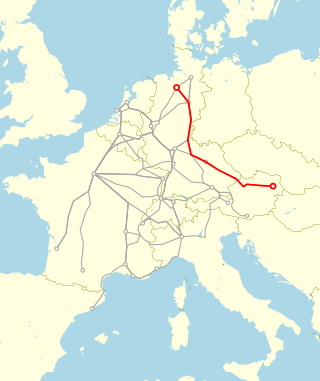
The Prinz Eugen was an express train that linked northern Germany with Wien Westbf in Vienna, Austria. Introduced in 1971, it was operated by the Deutsche Bundesbahn / Deutsche Bahn (DB) and the Austrian Federal Railways (ÖBB).

Task Force Thiele was an organizational unit of the German Kriegsmarine during World War II. It was named after its commander Vizeadmiral August Thiele who led the task force from 23 March 1945 until it was disbanded on 27 April 1945. It was formed from the Second Task Force which had been created on 28 July 1944 from the Baltic Sea Training Unit, also under command of Thiele.

Arthur Harrison "Speedy" Graubart was a United States Navy captain, and the last commander of the heavy cruiser Prinz Eugen after the ship's transfer as a war prize from Nazi Germany's Kriegsmarine to the US Navy.

SMS Prinz Eugen was an ironclad warship built for the Austro-Hungarian Navy in the 1870s, the third and final member of the Kaiser Max class. The ship was supposedly the same vessel that had been laid down in 1861, and had simply been reconstructed. In reality, the head of the Austro-Hungarian Navy could not secure funding for new ships, but reconstruction projects were uncontroversial, so he "rebuilt" the three earlier Kaiser Max-class ironclads. Only the engines and parts of the armor plate were reused in the new Prinz Eugen, which was laid down in October 1874, launched in September 1877, and commissioned in November 1878. The ship spent significant periods out of service, in part due to slender naval budgets that prevented much active use. In 1880, she took part in an international naval demonstration against the Ottoman Empire, and she went to Spain in 1888 for the Barcelona Universal Exposition. Prinz Eugen was stricken in 1904 and converted into a repair ship in 1906–1909. She was renamed Vulkan and served in this capacity through World War I; after the war, she was seized by Italy but was awarded to Yugoslavia in the postwar peace negotiations. Italy refused to hand the ship over, however, and her ultimate fate is unknown.
Three ships of the Austrian and later Austro-Hungarian Navy have been named SMS Prinz Eugen in honor of Prince Eugene of Savoy
Reinicke is a surname. Notable people with the surname include:

MV Esso Hamburg was a supply tanker ordered from Deutsche Werft Finkenwerder in 1939 for the Panama Transport Company as MV Esso Colon. Later in 1939 ownership was transferred to the Deutsch-Amerikanische Petroleum company and she was launched as Esso Hamburg on 9 October 1939. She was subsequently used as an oiler for Bismarck and other German warships.
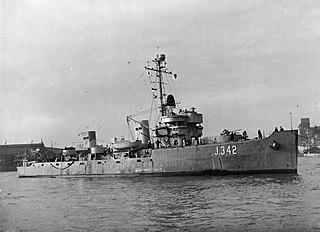
HMS Gazelle was a Catherine-class minesweeper of the Royal Navy.